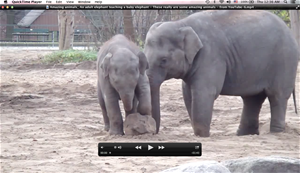 Where should I start? Teachers who are interested in incorporating digital tools in their classrooms often ask this question. One answer is: Add videos to your mix of teaching materials.
Where should I start? Teachers who are interested in incorporating digital tools in their classrooms often ask this question. One answer is: Add videos to your mix of teaching materials.
Videos are versatile; they can be used in numerous ways to enhance any unit of study. They are readily available for free on YouTube. They are easy for teachers and students to use, and no special software or equipment is needed. Best of all, videos are a powerful way to enrich what and how you already teach. For example, your students can take virtual field trips, observe changes over time with time-lapse photography, and learn directly from experts.
The use of videos requires mostly both time and thought. The key to making them work involves selecting, saving, and sharing. The following suggestions can help make your digital beginnings more manageable and successful.
Selecting videos
Finding just the right video to improve a unit of study is exciting. The video might help explain a difficult concept, reinforce material, or provoke discussion. Before you search YouTube, think about how some information might be easier to understand with the audio and visual components a video provides. As you start to search, be open to exploring some unexpected videos that come up for your topic, because sometimes they end up being the best ones to use. As you choose the videos that suit your goals, make sure to watch all of them to the end, in case there are any inappropriate surprises.
Saving videos
Once you have found the videos, saving them properly is important. The videos on YouTube do not always stay on YouTube, and it is disappointing when videos you want to use are no longer available. To keep a copy, use Offliberty. The site saves a video in just a few easy steps. The added benefits to saving videos are that they can be viewed without having to rely on Internet access and students do not need to go to YouTube to obtain them. Once you have the videos, it is simple to store them on your computer with each unit of study having a folder containing all the digital resources you use.
Sharing videos
The easiest way to share videos is by showing them to a group of students using an interactive whiteboards or a classroom computer. For students working in smaller groups or individually at multiple devices, one way to provide videos is through a shared folder if your school network is set up for it. The teacher drops the videos in a desktop folder that can be accessed by each student. If this option is not available, posting them on a site that is easily accessible to students, like a teacher page, may be necessary.
Videos can be incorporated in a variety of ways, such as introducing a unit, explaining information, demonstrating concepts, reviewing material, supplementing homework, or assessing understanding. They offer opportunities for deep examination, lively discussion, improved comprehension, and written reflection. Videos bring new life to old units of study and make new units easier to teach. They are free, readily available, easy to use, and enriching. For teachers interested in introducing digital tools in their classroom, using videos is one good place to start.
Karen Pelekis is a first-grade teacher at Greenacres Elementary School in Scarsdale, NY.
This article is part of a series from the Technology in Literacy Education Special Interest Group (TILE-SIG).